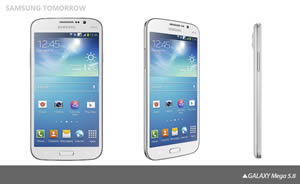Difference between Samsung Galaxy Mega 5.8 and Galaxy Note II
Key difference: Samsung has now expanded its’ offerings in the phablet category by introducing the Samsung Galaxy Mega 5.8 and Samsung Galaxy Mega 6.3. The Samsung Galaxy Mega 5.8 is named such because of its 5.8 inch TFT capacitive touchscreen, with a resolution of 540 x 960 pixels. The phone is powered by a Dual-core 1.4 GHz processor with a 1.5 GB RAM. The Samsung Galaxy Note II is known for its large display of 5.5 inches (141 mm), as well as its integral use of a stylus, called the S pen. The Note II features a 1.6 GHz quad-core processor, 720p resolution display, and 2 GB of RAM.

Samsung is a major player on the world smartphone platform. It is the second most popular smartphone retailer in the world by number of units sold, after Apple. It is in fact the first most popular Android smartphone retailer in the world by number of units sold. The company’s Samsung Galaxy S3 was the first phone that gave the iPhone a real competition. Hence, effectively making the Galaxy brand, a brand to be reckoned with.
Samsung is also credited with creating the ‘phablet’ category by introducing the Samsung Galaxy Note. A phablet is a cross between a phone and a tablet; it sized as a table but with all the properties of a phone. Samsung has now expanded its’ offerings in the phablet category by introducing the Samsung Galaxy Mega 5.8 and Samsung Galaxy Mega 6.3.
The Samsung Galaxy Mega 5.8 is named such because of its 5.8 inch TFT capacitive touchscreen, with a resolution of 540 x 960 pixels. The phone is powered by a Dual-core 1.4 GHz processor with a 1.5 GB RAM. The phone runs Android 4.2.2, the latest version of Android at the time of its launch. The phone also features an 8 MP primary camera and a 1.9 MP secondary front-facing camera.
In addition to the above mentioned features, the phone also boasts several features that are available on the Samsung Galaxy S4. This includes ‘Group Play’, which enables easy content sharing for up to 8 devices on the same Wi-Fi network; ‘Samsung WatchON’ that transforms the phone into an IR remote controller to connect to the home entertainment system; ‘Samsung Link’ for streaming photos, videos, notes, or music to the television, tablet or computer; ‘S Translator’ that provides instant translation, using text or voice translation on applications including email, and ChatON, which allows the user to share the phone’s screen with other users.

Furthermore, the phone also has a split screen capability that allows two or more applications to share the screen. These applications include email, messages, ‘MyFiles,’ ‘S Memo,’ ‘S Planner’, and more. The phone also has the popular ‘Air View’ feature, which allows users to preview information in emails, photos in Gallery, and speed dial contacts, before opening them. In addition, the ‘S Travel’ feature trip information, local guides and resources, etc., while the ‘Story album’ allows users to create albums of daily events, keep special moments in one place using a timeline, geo-tag information and publish digital albums in hard copy.
The Samsung Galaxy Note II is a smartphone manufactured by Samsung and is an Android based device. The Note II is known for its large display of 5.5 inches (141 mm), as well as its integral use of a stylus, called the S pen. The beauty of a Galaxy Note II is that it falls between the categories of a smartphone and a tablet. It is hence marketed as a ‘phablet’, a phone and a tablet, a hybrid or sorts.
In terms of hardware, the Note II features a 1.6 GHz quad-core processor, 720p resolution display, and 2 GB of RAM. The Note II is available in a variety of colors and in storage capacities of 16 GB, 32 GB and 64 GB. The phone also has an external expandable memory of up to 64 GB. The Galaxy Note II was launched with Android 4.1 (also called Jelly Bean) and at the time of its launch was the first phone to feature Android 4.1. Now, the phone is upgradeable to Android 4.1.2.s
The information for the detailed table about the two phones has been taken from the Samsung website, samsungmobilepress.com, samsungtomorrow.com, gdgt.com and GSMarena.com.
|
|
Samsung Galaxy Mega 5.8 |
Samsung Galaxy Note II |
|
Launch Date |
May 2013 |
26 September 2012 |
|
Company |
Samsung |
Samsung |
|
Size |
162.6 x 82.4 x 9 mm (6.40 x 3.24 x 0.35 in) |
151.1 x 80.5 x 9.4 mm (5.95 x 3.17 x 0.37 in) |
|
Display |
TFT capacitive touchscreen |
Super AMOLED capacitive touchscreen, 16M colors |
|
Screen |
540 x 960 pixels, 5.8 inches (~190 ppi pixel density) |
720 x 1280 pixels, 5.5 inches (~267 ppi pixel density) |
|
Protection |
- |
Corning Gorilla Glass 2 |
|
Weight |
182 g (6.42 oz) |
183 g (6.46 oz) |
|
2G Network |
GSM 850 / 900 / 1800 / 1900 - GT-I9150 GSM 850 / 900 / 1800 / 1900 - GT-I9152 (SIM 1 & SIM 2) |
GSM 850 / 900 / 1800 / 1900 |
|
3G Network |
HSDPA |
HSDPA 850 / 900 / 1900 / 2100 HSDPA 850 / 900 / 2100 - N7105 |
|
4G Network |
No |
LTE 800 / 900 / 1800 / 2600 - N7105 |
|
GUI |
TouchWiz UI |
TouchWiz UI |
|
CPU speed |
Dual-core 1.4 GHz |
Quad-core 1.6 GHz Cortex-A9 |
|
GPU |
- |
Mali-400MP |
|
OS |
Android OS, v4.2.2 (Jelly Bean) |
Android OS, v4.1.1 (Jelly Bean), upgradeable to 4.1.2 (Jelly Bean) |
|
Chipset |
TBA |
Exynos 4412 Quad |
|
RAM |
1.5 GB RAM |
2 GB RAM |
|
SIM Size |
TBA - Optional Dual SIM |
Micro-SIM |
|
Internal Memory |
8 GB |
16/32/64 GB |
|
Expandable Memory |
microSD, up to 64 GB |
up to 64 GB |
|
Sensors |
Accelerometer, Geomagnetic, Proximity, Light, Gyroscope |
Accelerometer, gyro, proximity, compass, barometer |
|
Connectivity |
Wi-Fi a/b/g/n, WiFi Direct BT 4.0(BLE), USB 2.0 H/S GPS+GLONASS |
Bluetooth v 4.0 (Apt-X Codec support) LE, USB 2.0 Host, WiFi 802.11 a/b/g/n (2.4 & 5 GHz), Wi-Fi HT40 Wi-Fi Direct, NFC, S Beam, Samsung AllShare Play & Control, Samsung AllShare Cast (WiFi Display), Mirroring & Extention, Samsung AllShare Framework |
|
Data |
GPRS, EDGE, WLAN, Bluetooth, USB |
WiFi, NFC, GPRS, EDGE, LTE (4G), USB |
|
Speed |
HSDPA, 21 Mbps; HSUPA, 5.76 Mbps |
HSDPA, 42 Mbps; HSUPA, 5.76 Mbps; LTE, Cat3, 50 Mbps UL, 100 Mbps DL |
|
WLAN |
Wi-Fi 802.11 a/b/g/n, dual-band, Wi-Fi Direct, Wi-Fi hotspot |
Wi-Fi 802.11 a/b/g/n, dual-band, DLNA, Wi-Fi Direct, Wi-Fi hotspot |
|
Bluetooth |
Yes, v4.0 with A2DP, LE |
Bluetooth v4.0 with A2DP, LE, EDR |
|
USB |
No |
microUSB v2.0 (MHL), USB Host |
|
Primary Camera |
8 MP, 3264 x 2448 pixels, autofocus, LED flash |
8 MP, 3264x2448 pixels, autofocus, LED flash |
|
Secondary Camera |
1.9 MP |
1.9 MP |
|
Video |
Yes, 1080p@30fps |
1080p@30fps |
|
Camera Features |
autofocus, LED flash, Geo-tagging, touch focus, face and smile detection, Beauty Face, Best Photo, Best Face, Drama, Rich Tone (High Dynamic Range), Sound & Shot, Sports, Continuous shot |
Simultaneous HD video and image recording, geo-tagging, touch focus, face and smile detection, image stabilization |
|
Sound Enhancement |
- |
SNS integration Active noise cancellation with dedicated mic |
|
Audio supported formats |
MP3, M4A, AAC, OGG, OGA, WAV, WMA, AMR, AWB, FLAC, MID, MIDI, XMF, MXMF, IMY, RTTTL, RTX, OTA |
MP3/WAV/eAAC+/AC3/FLAC player |
|
Video supported formats |
MP4, M4V, 3GP, 3G2, WMV, ASF, AVI, FLV, MKV, WEBM |
MP4/DivX/XviD/WMV/H.264/H.263 player |
|
Battery Capacity |
Li-Ion 2600 mAh battery |
Standard battery, Li-ion 3,100mAh |
|
Available Colors |
White, Black |
Titanium Gray, Marble White, Amber Brown, Ruby Wine, Pink |
|
Messaging |
SMS(threaded view), MMS, Email, Push Mail, IM, RSS |
SMS(threaded view), MMS, Email, Push Mail, IM, RSS |
|
Browser |
HTML5 |
HTML5 |
|
Radio |
No |
Stereo FM radio with RDS (N7100 only) |
|
GPS |
Yes, with A-GPS support and GLONASS |
with A-GPS support and GLONASS |
|
Java |
Yes, via Java MIDP emulator |
Java MIDP emulator |
|
Additional Features |
|
|
Image Courtesy: samsungtomorrow.com, allthingsd.com









Add new comment